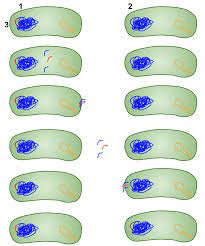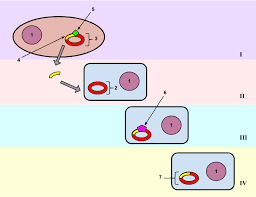Bacterial TransformationTransformation is a process through which an organism's genetic material (DNA) is transferred to another organism. When exogenous DNA is transferred into an organism, the organism is said to be competent. Competence is a property that enables the organism to successfully uptake foreign DNA into its system. 
Bacterial transformation transfers foreign DNA from one bacterium to another bacterium. The bacteria from which the DNA is transferred are called donor bacteria, and the bacteria that receive the foreign DNA are called recipient bacteria. DNA is first transferred to the extracellular environment, where the recipient bacterium absorbs it. As a result, the bacteria receiving the new DNA acquires new characteristics. This method does not need a live donor cell and instead relies on free DNA in the environment. The transformant is the receiver who successfully propagates the new DNA. Under harsh environmental circumstances, certain bacterial species spontaneously release DNA from their cells into the environment, where competent organisms may pick it up. Competent cells react to environmental changes and manage the degree of gene uptake through a natural transformation process. Transformation is the most commonly used gene transfer technique because it allows the transfer of intentionally changed DNA into recipient cells. The transformation method may transfer DNA sections ranging from one to tens of kilobases in size. The Principle of Bacterial TransformationThe basic principle behind the transformation is the capability of the donor bacterium to release its DNA and the competent behavior of the recipient bacteria to receive DNA successfully. 
The competence of the host cell determines the success of the transformation. Competence is a cell's capacity to assimilate bare DNA throughout the transformation process. Organisms that are naturally transformable spontaneously release their DNA by autolysis in the late stationary phase. Several bacteria, including E. coli, may be treated artificially in the laboratory to boost their transformability using substances such as calcium, a strong electric field (electroporation), or a heat shock. Researchers employ different techniques to enhance the competence of recipient bacteria. Electrophoresis and the heat shock method are two of the most frequently used techniques. These techniques increase the competent behavior of bacteria by increasing the cell wall permeability and allowing for DNA to enter the cell. The transformation process is widely used in research because selecting a transformed colony is easy. The transformed colony can be easily selected if the foreign DNA has any selectable marker attached to it, like antibiotic resistance. Selectable markers serve the purpose of giving a unique trait to the bacteria. For example, if the foreign DNA has antibiotic resistance as a selectable marker, the bacterial population can grow on the antibiotic. All the bacteria which can survive in that medium are transformed bacteria. In this way, transformed and non-transformed organisms can be distinguished. The process of acquiring free DNA into the cell is simple. Free DNA attaches to the bacterial cell wall, and through its competent behavior, DNA is integrated into the chromosomal DNA by entering the cell wall. Electroporation or heat shock improves Competence by increasing the permeability of the cell wall, allowing donor DNA to enter. Similarly, if the converted DNA has a selectable marker, such as antibiotic resistance, or if the DNA encodes for using a growth factor, such as an amino acid, transformants may be chosen. Free DNA attaches to the bacterium in most naturally competent bacteria, and the DNA is integrated into the chromosomal DNA. Sometimes free DNA is inserted into a plasmid that can replicate independently of the chromosome, eliminating the need for the insert to be integrated into the chromosome. After transformation, the plasmid encodes certain enzymes and antibiotic-resistant markers expressed in the transformant. The donor DNA is initially introduced into the plasmid during this transformation phase. Then it is subsequently introduced into the competent host bacterium. Once the transformation process is completed, the recipient bacteria that have brought the plasmid is easily recognized by using a growth medium treated with the antibiotic. Steps in Bacterial TransformationThe transformation consists of four steps:

Electroporation or heat shock therapy may be used to accomplish artificial competence development. The option is determined by the desired transformation efficiency, experimental aims, and accessible resources. The cell-DNA combination is held on ice (0°C) before being subjected to 42°C for heat shock. The mixture is transported to an electroporator and subjected to a short pulse of a high-voltage electric field for electroporation.The double-stranded DNA produced by lysed cells interacts with cell surface receptors non-covalently. Because there is no DNA sequence-specific recognition, these creatures may integrate DNA from other species. Now the membrane-bound endonuclease comes into play. They nick the strands of dsDNA into small pieces. This way, donor DNA is converted into ssDNA. ssDNA can easily bypass the cell wall and enter the cell with the help of a membrane-spanning DNA translocation channel. Then this ssDNA integrates into the recipient bacterial chromosome by recombination. Foreign DNA replaces a portion of the bacterial chromosome during this process. This integration, however, requires considerable nucleotide sequence similarity between the donor DNA fragment and the chromosomal region. During the electroporation or heat shock transformation, donor DNA is transferred through the plasmid. Plasmid carries the donor DNA along with the selectable marker. Therefore, a plasmid containing cells can be identified using the property of selectable marker present in transformed cells and absent in untransformed cells. Bacterial Transformation TypesTransformation may have two forms:
Next TopicBacterial Artificial Chromosome
|
 For Videos Join Our Youtube Channel: Join Now
For Videos Join Our Youtube Channel: Join Now
Feedback
- Send your Feedback to [email protected]
Help Others, Please Share









